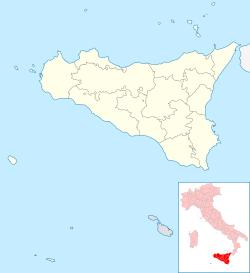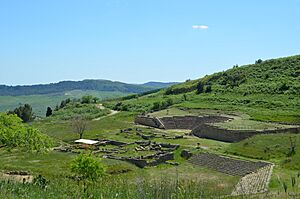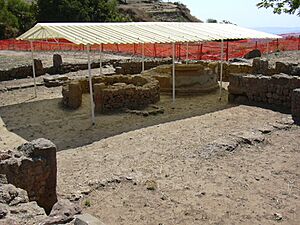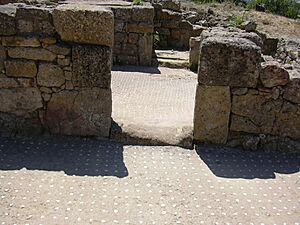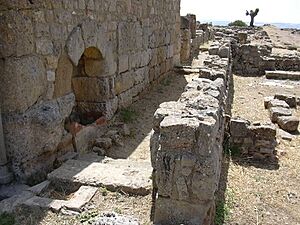Morgantina facts for kids
|
Μοργάντιον / Μοργαντίνη
|
|

View of Morgantina's Hellenistic agora. An Iron Age settlement was located on the Cittadella hilltop in the background. Mount Etna is seen in the distance.
|
|
| Alternative name | Morgantia, Morgantium, Morgentia, Murgantia, Murgentia |
|---|---|
| Location | Aidone, Province of Enna |
| Coordinates | 37°25′51″N 14°28′46″E / 37.43083°N 14.47944°E |
| Type | Settlement |
| History | |
| Periods | Late Bronze Age to Roman Republic |
| Site notes | |
| Excavation dates | 1884, 1912, 1955–1963, 1966–1967, 1968–1972, 1978–present |
| Archaeologists | Luigi Pappalardo, Paolo Orsi, Erik Sjöqvist, Richard Stillwell, Hubert L. Allen, William A. P. Child, Malcolm Bell III, Carla Antonaccio |
| Management | Soprintendenza BB.CC.AA. di Enna |
| Website | Area Archeologica Morgantina |
Morgantina (also known as Morgantion or Morgantine) is an ancient archaeological site in central Sicily, southern Italy. It is about 60 kilometers (37 miles) from the Ionian Sea coast, in the province of Enna. The closest modern town is Aidone, just two kilometers (1.2 miles) away.
The site is made up of two main areas: a long ridge called Serra Orlando and a nearby hill to the northeast called Cittadella. Morgantina was home to people during different times in history. The first major settlement was on Cittadella, lasting from about 1000 BCE to 450 BCE. Later, a large settlement grew on Serra Orlando, existing from about 450 BCE until around 50 CE. This was during the time of Magna Graecia, when ancient Greeks settled in southern Italy and Sicily. Archaeologists have been studying Morgantina since the early 1900s.
The site at Serra Orlando was identified as Morgantina by a researcher named Kenan Erim. He found coins with the Latin word HISPANORUM on them. Using these coins and old writings, Erim showed that the city found at Serra Orlando was indeed the ancient city of Morgantina.
Contents
A Glimpse into Morgantina's Past
The name Morgantina appears in different forms in old texts, like Morgantia or Murgantia. Ancient writers like Strabo and Diodorus Siculus used slightly different spellings. The people who lived there were called Murgentini.
Early Settlers and Conflicts
According to Strabo, Morgantina was founded by an ancient Italian group called the Morgetes. Their king was named Morges. The first historical event linked to Morgantina happened in 459 BCE. At that time, Ducetius, a leader of the native Sicels (an ancient people of Sicily), attacked and captured the city. Morgantina was likely still under Ducetius's control when he was defeated by Syracuse in 449 BCE.
Changing Hands and Roman Rule
Morgantina is mentioned again in a peace agreement during a war between Syracuse and other Sicilian cities in 427–424 BCE. Syracuse agreed to give Morgantina to Kamarina in exchange for payment. However, Kamarina was destroyed in 405 BCE. Morgantina became independent for a short time but was soon recaptured by Dionysios of Syracuse in 396 BCE. Syracuse kept control of Morgantina, though sometimes it was more in name than in reality, until the Second Punic War.
In 317 BCE, Morgantina helped Agathocles, who was in exile, return to Syracuse. He was elected a leader in Morgantina before becoming a powerful ruler in Syracuse.
As part of the Syracusan kingdom, Morgantina came under Rome's influence when its king, Hiero II, became a Roman ally in 263 BCE. But in 214 BCE, Morgantina changed its loyalty from Rome to Carthage. Morgantina remained independent until 211 BCE, when it was the last Sicilian town to be captured by the Romans. The Romans then gave the city as payment to a group of Spanish soldiers.
Later History and Decline
In 133 BCE, Morgantina was where Eunus, the leader of a large slave rebellion known as the First Servile War, died. Later, during the Second Servile War, Morgantina was attacked and taken by slaves again. The last mention of Morgantina comes from Strabo, who noted that by the first century CE, the city no longer existed.
Morgantina's Famous Grapes
Some old writings describe Morgantina and its economy. The most famous mentions are about the vitis murgentina, a special type of grape. Writers like Cato the Elder and Pliny the Elder praised these grapes for their excellent wine. Pliny even called it "the very best among all those that come from Sicily." These grapes were so good that they were moved from Sicily to mainland Italy by the 2nd century BCE.
Uncovering Morgantina's Secrets
Archaeologists have been working for many years to uncover the history of Morgantina.
Early Digs
The first excavations at Morgantina were done by Luigi Pappalardo in 1884. He found part of an ancient burial ground, a large clay drain, and two houses. One of these houses was later named the Pappalardo house.
Paolo Orsi also found items from Morgantina and dug test trenches in 1912. He discovered a terrace with nine steps, some walls, and what he called 'a Roman house'.
Princeton University's Role
In 1955, Princeton University started a major project at Morgantina. Professors Erik Sjöqvist and Richard Stillwell led the work. The goal was to train students in archaeology. Many important archaeologists, including Kenan Erim, worked on the site. Even King Gustaf VI Adolf of Sweden visited Morgantina several times in the 1950s to help with the digs.
Continuing the Work
In the mid-1960s, Hubert L. Allen, a Princeton student, helped manage the excavations. Later, the University of Illinois joined as a co-sponsor. After Sjöqvist and Stillwell retired, Princeton stopped its direct involvement. Allen continued to lead the project until 1975.
University of Virginia and Wesleyan University
By 1978, a lot of artifacts had been found, but the full results hadn't been published. Malcolm Bell III, a professor from the University of Virginia, took over the project. His goal was to publish all the findings. Bell has continued to investigate Serra Orlando since 1982, focusing on specific questions from earlier work. He used his research as the basis for the Morgantina Studies book series, which is the main way the excavation results are shared.
In 1990, Carla Antonaccio, from Wesleyan University, took charge of publishing information about the settlement on Cittadella. Today, many universities from America and Italy send scholars and students to Morgantina to do research.
Returning Stolen Art
In the 1980s, several valuable artworks that had been illegally taken from Morgantina were sold to collectors and museums. These included a statue of Aphrodite bought by the J. Paul Getty museum and the Morgantina treasure bought by the Metropolitan Museum of Art. Thankfully, all these artworks were returned to Italy and are now on display at the museum in Aidone.
North Baths and Bouleuterion
Since 2003, Sandra K. Lucore has led excavations of the North Baths, a building from the 3rd century BCE. Her team found exciting evidence of some of the earliest examples of dome and barrel vault construction.
The bouleuterion in Morgantina was a rectangular building west of the city's agora (public square). It was built in the 3rd century BCE, a time when Morgantina was very successful and had a strong Greek influence. This building had a main hall where people would gather. Today, only the foundations and parts of the south side remain.
Archaeological Museum of Aidone
A museum was opened in Aidone in 1980 to display the artifacts found at Morgantina. The museum is located in a former Capuchin monastery that dates back to the 17th century. It has two floors of exhibits, showing items from Morgantina's prehistoric, archaic, and classical periods. There are also displays that highlight what daily life was like in ancient times.
See also
- Morgantina treasure
- List of ancient Greek cities


